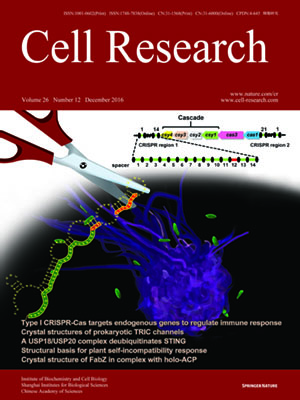
Volume 26, No 12, Dec 2016
ISSN: 1001-0602
EISSN: 1748-7838 2018
impact factor 17.848*
(Clarivate Analytics, 2019)
Volume 26 Issue 12, December 2016: 1302-1319
ORIGINAL ARTICLES
USP18 recruits USP20 to promote innate antiviral response through deubiquitinating STING/MITA
Man Zhang1,*, Meng-Xin Zhang1,*, Qiang Zhang1, Gao-Feng Zhu1, Lei Yuan1, Dong-Er Zhang4, Qiyun Zhu3, Jing Yao1, Hong-Bing Shu2 and Bo Zhong1,2
1State Key Laboratory of Virology, Hubei Key Laboratory of Cell Homeostasis, College of Life Sciences, Wuhan University, Wuhan 430072, China
2Medical Research Institute, School of Medicine, Wuhan University, Wuhan 430071, China
3State Key Laboratory of Veterinary Etiological Biology, Lanzhou Veterinary Research Institute, Chinese Academy of Agricultural Sciences, Lanzhou 730046, China
4Department of Pathology and Division of Biological Sciences, Moores UCSD Cancer Center, University of California San Diego, La Jolla, California 92093, USA
Correspondence: Bo Zhong, Tel: 86-27-68752202; Fax: 86-27-68752246 E-mail: zhongbo@whu.edu.cn
STING (also known as MITA) mediates the innate antiviral signaling and ubiquitination of STING is key to its function. However, the deubiquitination process of STING is unclear. Here we report that USP18 recruits USP20 to deconjugate K48-linked ubiquitination chains from STING and promotes the stability of STING and the expression of type I IFNs and proinflammatory cytokines after DNA virus infection. USP18 deficiency or knockdown of USP20 resulted in enhanced K48-linked ubiquitination and accelerated degradation of STING, and impaired activation of IRF3 and NF-κB as well as induction of downstream genes after infection with DNA virus HSV-1 or transfection of various DNA ligands. In addition, Usp18−/− mice were more susceptible to HSV-1 infection compared with the wild-type littermates. USP18 did not deubiquitinate STING in vitro but facilitated USP20 to catalyze deubiquitination of STING in a manner independent of the enzymatic activity of USP18. In addition, reconstitution of STING into Usp18−/− MEFs restored HSV-1-induced expression of downstream genes and cellular antiviral responses. Our findings thus uncover previously uncharacterized roles of USP18 and USP20 in mediating virus-triggered signaling and contribute to the understanding of the complicated regulatory system of the innate antiviral responses.
10.1038/cr.2016.125
FULL TEXT | PDF
Browse 1974


